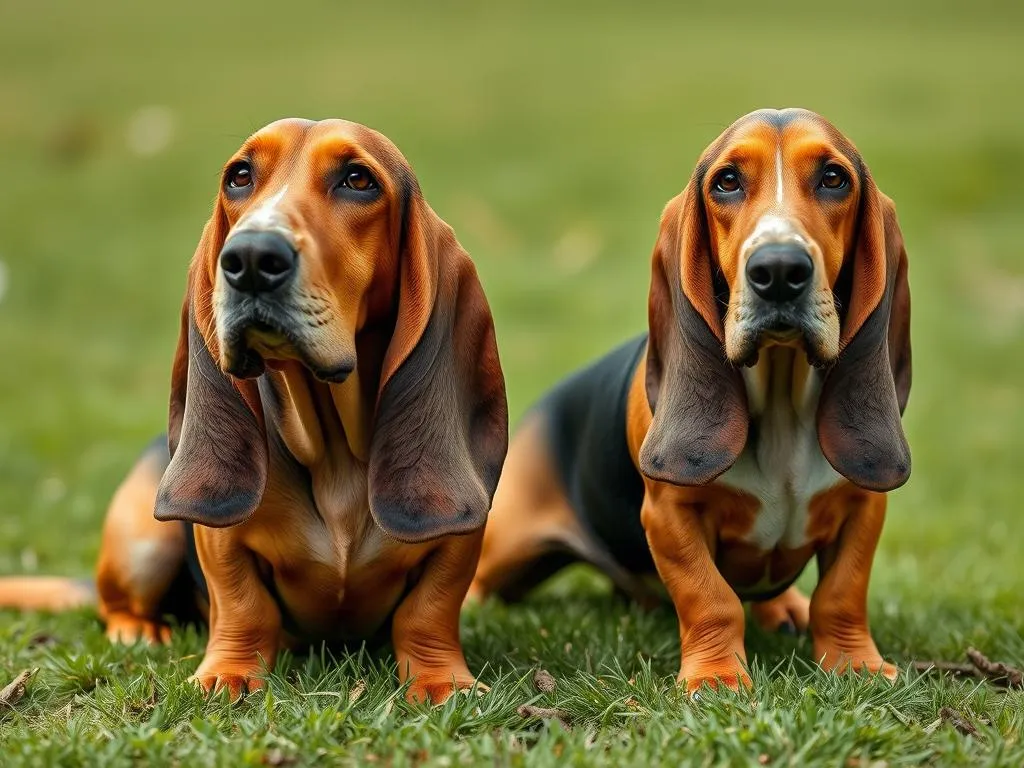
Introduction
When considering a dog for your family or lifestyle, understanding the unique characteristics of different breeds becomes essential. Among the many breeds available, the Basset Hound and the Bloodhound stand out due to their distinct features and temperaments. This article dives deep into the comparison of these two fascinating breeds, helping potential dog owners make informed decisions based on their preferences and lifestyles.
Breed Backgrounds
Basset Hound
The Basset Hound has a rich history that dates back to France in the early 16th century. Originating from the word “bas” meaning “low,” this breed was specifically developed for hunting small game, thanks to its remarkable sense of smell and tracking abilities. The Basset Hound’s short legs and elongated body allow it to navigate through thick underbrush while its keen nose can pick up scents trails left by animals.
In terms of physical characteristics, Basset Hounds typically weigh between 40 to 65 pounds and stand around 14 to 15 inches tall at the shoulder. Their signature features include long, droopy ears and soulful, expressive eyes. The coat is short and can come in various colors, including tri-color (black, white, and brown) and lemon (light tan and white).
Temperamentally, Basset Hounds are known for their friendly disposition. They are loyal companions who are generally good with children and other pets. However, their stubbornness can sometimes make training a challenge, as they may prefer to follow their noses rather than obey commands.
Bloodhound
The Bloodhound, on the other hand, has a storied past that traces back to the Middle Ages in Belgium. Bred primarily for tracking, this breed has been utilized in search and rescue, as well as in law enforcement due to its unparalleled sense of smell. The breed’s ability to follow a scent trail can be traced back days, making it an invaluable asset for tracking down missing persons or fugitives.
Bloodhounds are larger than Basset Hounds, typically weighing between 80 to 110 pounds and standing about 23 to 27 inches tall at the shoulder. They possess loose, wrinkled skin and long ears that enhance their scenting abilities. Their coat is short and can be found in various colors, including black and tan, liver and tan, and red.
In terms of temperament, Bloodhounds are known for being gentle and friendly. They are intelligent but can also be independent, which may pose challenges during training. Their affectionate nature makes them great companions, especially in families.
Comparison of Traits
Physical Differences
When comparing the Basset Hound vs Bloodhound, the most noticeable difference is their size. The Basset Hound is a small to medium-sized breed, while the Bloodhound is considerably larger and more robust.
| Trait | Basset Hound | Bloodhound |
|---|---|---|
| Average Weight | 40 – 65 lbs | 80 – 110 lbs |
| Average Height | 14 – 15 inches | 23 – 27 inches |
| Coat Type | Short and smooth | Short and smooth |
In terms of grooming needs, both breeds have relatively low grooming requirements due to their short coats. However, Basset Hounds may require more frequent ear cleaning because of their long ears, which can trap moisture and cause infections. Bloodhounds, with their loose skin, may also need regular checks for any skin irritations.
Temperament and Trainability
The temperament of these two breeds presents some intriguing contrasts. Basset Hounds are known for their laid-back and easy-going nature, making them great family dogs. They are often described as affectionate and loyal, but their stubbornness can lead to challenges in training. Consistent, positive reinforcement is key to managing their independent streak.
Bloodhounds, while also friendly and loyal, exhibit a more independent nature. They are intelligent dogs, but their strong instincts can sometimes lead them to be distracted during training sessions. Socialization from a young age and patience are essential to help them become well-rounded companions.
Health Considerations
Both breeds are prone to certain health issues, which potential owners should be aware of.
- Basset Hound Health Concerns:
- Hip dysplasia
- Ear infections
- Obesity
-
Intervertebral disc disease
-
Bloodhound Health Concerns:
- Hip dysplasia
- Elbow dysplasia
- Bloat
- Ear infections
The average lifespan of a Basset Hound is around 10 to 12 years, while Bloodhounds typically live a bit longer, averaging between 10 to 15 years. Regular vet check-ups and a healthy diet can help mitigate some of these health risks.
Suitability and Lifestyle
Ideal Living Conditions
When considering the Basset Hound vs Bloodhound, it’s important to evaluate their living conditions. Basset Hounds adapt well to apartment living due to their moderate exercise needs and calm demeanor. They thrive in homes where they can spend time with their families but do require some outdoor space to explore and sniff around.
Bloodhounds, on the other hand, need more space to roam and explore. They are best suited for homes with large yards where they can engage in their natural instinct to track scents. Daily exercise is essential for both breeds, but Bloodhounds require more vigorous activities to keep them mentally and physically stimulated.
Exercise Needs
While both breeds enjoy their playtime, the Bloodhound typically requires more exercise than the Basset Hound. Basset Hounds enjoy leisurely walks and play sessions but can be satisfied with moderate exercise due to their laid-back nature. Daily walks of about 30 minutes should suffice to keep them healthy and happy.
In contrast, Bloodhounds thrive on physical activity and require more vigorous exercise. They benefit from daily walks, runs, or playtime that allows them to engage in their natural tracking behavior. A minimum of one hour of exercise per day is recommended for a Bloodhound.
Family Compatibility
Both breeds can be excellent family pets, but their compatibility with children and other pets may vary. Basset Hounds are generally gentle with children and can cohabitate well with other pets, including dogs and cats. Their friendly nature makes them great companions for families looking for a loyal friend.
Bloodhounds are also good with children and can be affectionate towards family members. However, their large size and energetic nature mean they should be supervised around young children to avoid accidental knocks. They can coexist peacefully with other pets if introduced properly, but their strong prey drive may make them less suitable for homes with small animals.
Popularity and Adoption
Breed Popularity
In terms of popularity, both breeds have their dedicated fan bases. According to the American Kennel Club (AKC), the Basset Hound is consistently ranked among the top 50 breeds, while the Bloodhound typically falls slightly lower in the rankings but remains well-loved for its unique abilities and charm.
Adoption and Rescue Options
For those considering adding a Basset Hound or Bloodhound to their family, adoption is a fantastic option. Local shelters and breed-specific rescues often have these breeds available for adoption. Potential owners should look for reputable rescues or organizations dedicated to the welfare of these breeds.
When adopting a rescue, it’s important to consider the dog’s history and any potential behavioral issues. Both breeds can come with their unique challenges, so patience and understanding are key to a successful adoption.
Conclusion
In summary, when weighing the Basset Hound vs Bloodhound, prospective dog owners should consider their living situations, exercise needs, and family dynamics. Basset Hounds are affectionate, low-maintenance dogs that fit well into various living environments, while Bloodhounds are energetic, intelligent dogs that thrive on activity and space.
Choosing between these two breeds ultimately depends on individual preferences and lifestyles. By understanding the key differences and similarities, potential owners can make an informed decision that leads to a happy and fulfilling relationship with their new canine companion.









